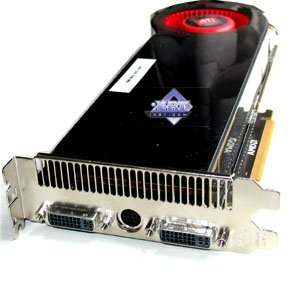Unlike the 4870 cards with 512 MB of memory, which are already available in stores, this product carries 2 x 1024 MB (2 GB in total). But you should know that it's wrong to sum up memory size in dual-GPU graphics cards. Each core uses only its own memory block, there is no such thing as common memory. So only a marketing department can sum up memory size and demonstrate a card with allegedly big memory volume.
Graphics card
| ATI RADEON HD 4870 X2 2x1024MB |
- GPU: 2 x RADEON HD 4870 (RV770)
- Interface: PCI-Express x16
- GPU frequencies (ROPs/Shaders): 750/750 MHz (nominal -- 750/750 MHz)
- Memory frequencies (physical (effective)): 900 (3600) MHz (nominal -- 900 (3600) MHz)
- Memory bus width: 2 x 256bit
- Vertex processors: -
- Pixel processors: -
- Unified processors: 2 x 800
- Texture processors: 2 x 40 (BLF/TLF)
- ROPs: 2 x 16
- Dimensions: 270x100x33 mm (the last figure is maximum thickness of the graphics card).
- PCB color: black
- RAMDACs/TDMS: integrated into GPU.
- Output connectors: 2xDVI (Dual-Link/HDMI), TV-out.
- VIVO: not available
- TV-out: integrated into GPU.
- Multi-GPU operation: CrossFire (Hardware).
|
 |
| ATI RADEON HD 4870 X2 2x1024MB |
The graphics card has 2x1024 MB of GDDR5 SDRAM allocated in 16 chips (8 on the front and 8 on the back side of the PCB).
Hynix memory chips (GDDR5). These memory chips are designed for the maximum frequency of 1000 (4000) MHz. |
 |
| Comparison with the reference design, front view |
| ATI RADEON HD 4870 X2 2x1024MB |
Reference ATI RADEON HD 3870 X2 2x512MB |
 |
 |
 |
| Comparison with the reference design, back view |
| ATI RADEON HD 4870 X2 2x1024MB |
Reference ATI RADEON HD 3870 X2 2x512MB |
 |
 |
The concept of this design has apparently migrated from the 3870 X2. The only changes have to do with DDR5 memory peculiarities and higher power circuit requirements. The card is equipped with a new PEX bridge from PLX Technologies to set up internal CrossFire mode between the GPUs.
Graphics cards of this family are equipped with built-in audio codec. So this audio stream is then transmitted to HDMI (via a DVI-to-HDMI adapter). So if this function is important to you, make sure the bundle includes this adapter.
Also note that the graphics card uses two 6-pin power connectors. They are installed exactly as in the 3870 X2.
The card has TV-Out with an original connector. You will need a special bundled adapter to output video to a TV set via S-Video or RCA.
Analog monitors with D-Sub (VGA) interface are connected with special DVI-to-D-Sub adapters. The bundle also includes DVI-to-HDMI adapters (these graphics cards support video/audio transfer to HDMI receivers), so there should be no problems with such monitors.
Maximum resolutions and frequencies:
- 240 Hz Max Refresh Rate
- 2048 x 1536 x 32bit x85Hz Max -- analog interface
- 2560 x 1600 @ 60Hz Max -- digital interface (all DVIs with Dual-Link)
What concerns MPEG2 playback features (DVD-Video), we analyzed this issue in 2002. Little has changed since that time. CPU load during video playback on modern graphics cards does not exceed 25%.
What concerns HDTV, a review is available here.
Cooler
The cooling system is exactly as in the 3870 X2 card. Only the heatsinks have been changed.
The operation principle is the same: a turbine drives air through the heat sink. There is a big advantage: hot air is blown out of enclosure and does not stay inside. There are some drawbacks as well. While cooler on 3870 X2 remained noiseless, this one may become quite noisy under load due to air being ejected from the enclosure. Memory chips on the PCB back are cooled with a special plate.
Unfortunately, RivaTuner (written by A.Nikolaychuk AKA Unwinder) does not support the new family yet, so we don't have monitoring results. However, the card grows very hot. According to our first impressions, core temperatures may reach 80°C or higher.
Write a comment below. No registration needed!
